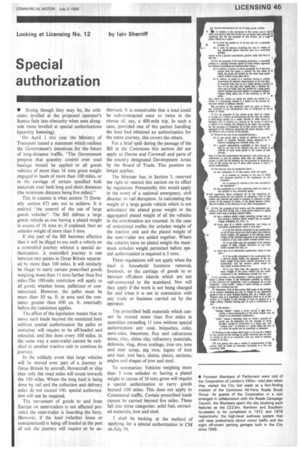Looking at Licensing No. 12 by lain Sherriff
Page 47

If you've noticed an error in this article please click here to report it so we can fix it.
Special authorization
• Strong though they may be, the criticisms levelled at the proposed operator's licence fade into obscurity when seen alongside those levelled at special authorizations (quantity licensing).
On April 3 this year the Ministry of Transport issued a statement which outlines the Government's intentions for the future of long-distance traffic. "The Government propose that quantity control over road haulage should be applied to all goods vehicles of more than 16 tons gross weight engaged in hauls of more than 100 miles, or in the carriage of certain specified bulk materials over both long and short distances (the minimum distance being five miles)."
This in essence is what section 71 (formerly section 67) sets out to achieve. It is entitled "the control of the use of large goods vehicles". The Bill defines a large goods vehicle as one having a plated weight in excess of 16 tons or, if unplated, then an unladen weight of more than 5 tons.
If this part of the Bill becomes effective then it will be illegal to use such a vehicle on a controlled journey without a special authorization. A controlled journey is one between two points in Great Britain separated by more than 100 miles. It will similarly be illegal to carry certain prescribed goods weighing more than 11 tons farther than five miles.The 100-mile restriction will apply to all goods whether loose, palletized or containerized. However, the pallet must be more than 50 sq. ft. in area and the container greater than 600 cu. ft. externally before the restriction applies.
The effect of the legislation means that to move such loads beyond the restricted limit without special authorization the pallet or container will require to be off-loaded and reloaded, and this done every 100 miles. In the same way a semi-trailer cannot be switched to another tractive unit to continue its journey.
In the unlikely event that large vehicles will be moved over part of a journey in Great Britain by aircraft, Hovercraft or ship then only the road miles will count towards the 100 miles. Where the long haul is being done by rail and the collection and delivery miles do not exceed 100, special authorization will not be required.
The movement of goods to and from Europe on semi-trailers is not affected provided the semi-trailer is boarding the ferry. However, if the load (whether loose or containerized) is being off-loaded at the port of exit the journey will require to be au
thorized. It is conceivable that a load could be sub-contracted once or twice in the course of, say, a 400-mile trip. In such a case, provided one of the parties handling the load had obtained an authorization for the entire journey, this covers the others.
For a brief spell during the passage of the Bill in the Commons this section did not apply to Devon and Cornwall and parts of the country designated Development Areas by the Board of Trade. This position no longer applies.
The Minister has, in Section 5, reserved the right to rescind this section on its effect by regulation. Presumably this would apply in the event of a national emergency, civil disaster, or rail disruption. In calculating the weight of a large goods vehicle which is not articulated the plated gross weight or the aggregated plated weight of all the vehicles in the combination are counted. In the case of articulated outfits the unladen weight of the tractive unit and the plated weight of the semi-trailer are added together. Where the vehicles have no plated weight the maxi. mum unladen weight permitted 'before special authorization is required is 5 tons.
These regulations will not apply when the load is household furniture removal, livestock, or the carriage of goods to or between off-shore islands which are not rail-connected to the mainland. Nor will they apply if the work is not being charged for and when it is not in connection with any trade or business carried on by the Operator.
The prescribed bulk materials which cannot be moved more than five miles in quantities exceeding 11 tons without special authorization are: coal, briquettes, coke, semi-coke, limestone,' flux and calcareous stone, clay, china clay refractory materials, dolomite, slag, dross scalings, iron ore, iron and steel scrap, pig iron, ingots of iron and steel, and bars, sheets, plates, sections, angles and shapes of iron and steel.
To summarize: Vehicles weighing more than 5 tons unladen or having a plated weight in excess of 16 tons gross will require a special authorization to carry goods beyond 100 miles. This does not apply to Continental traffic. Certain prescribed loads cannot he carried beyond five miles. These fall into three categories: solid fuel, extracted materials, iron and steel.
I shall be looking at the method of applying for a special authorization in CM on July 19.
























































































































































